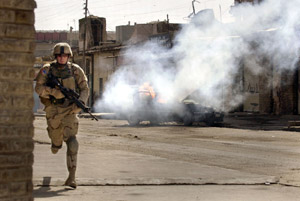| Home | Blog | Ask This | Showcase | Commentary | Comments | About Us | Contributors | Contact Us |

Who are these insurgents?ASK THIS | March 80, 2005A historian of Iraq writes that who they are, what they want, and what Iraqis think of them are crucial questions that must be answered before the insurgency can be put down -- and U.S. troops can come home. By Phebe Marr Q. What groups comprise the insurgency? How do their constituencies differ? Q. What are their aims? Is there a comprehensive view emerging among opponents of the new regime? Do they have goals and objectives over which there could be negotiations? Q. What attitudes do Iraqis have toward the insurgency? Why do they think the insurgency persists? What sort of measures, including negotiations, would they support to weaken it? Do these attitudes vary by region? What do people in the Sunni areas think, as compared to Baghdad, Kurdish cities like Irbil or the south? Q. What Iraqi forces are taking shape in Iraq? Q. Does the U.S. have a counter-insurgency strategy? If so, what is it? Can it be clearly described? We have some vague understanding of the groups who make up the insurgency. They include outsiders connected to Al Qaeda; insiders opposed to the new order; ex-Baathists and other nationalists. But we could use a better political anatomy. The groups are diverse and not always in agreement. We know that the Sunni oppositionists alone have varied motivations and goals. Those include resentment at exclusion from the new order; a desire to return to power and privilege; anti-colonial and anti-occupation feelings; plain old nationalism; fear of Shiite and Iranian influence; religious sentiments, etc. Is a common ideology or set of objectives emerging? If so, what is it? Can the various ideological elements of the insurgency be deconstructed? Knowing goals and objectives would help identify "moderates" with whom the new government could deal. It would also help clarify what the more moderate elements would need to be given to acquire a stake and an interest in the new order. It would also indicate the dimensions of how difficult this might or might not be. Understanding the attitude of the Iraqi populace toward the insurgency is critical, because the insurgency will last as long as it gets support -- tacit and active -- from within Iraqi society. Unless the government comes up with a viable strategy for dealing with it that includes political, as well as military, measures, the insurgency will continue. Views on the matter will vary greatly, but understanding the parameters for action that Iraqis in general would support – and would be willing to take themselves -- would help in devising that strategy. Outsider Sunni “jihadis” have been trying to incite a civil war in Iraq between Shiites and Sunnis and between Kurds and Arabs. They have been killing Kurds in Mosul, and Shiites in Baghdad and the south, for example. But Shiite and Kurdish leaders, who are participating in government, are acutely aware of this danger and have been remarkably disciplined in dealing with the situation, urging restraint on their communities and rejecting “revenge” responses. The Shiites have reined in the “hothead” Shiite cleric Muqtada-l-Sadr, for example, while Kurds have avoided major violence in Kirkuk. These responses demonstrate how eager leaders are to avoid open civil warfare. A capable Iraqi military force is apparently a prerequisite to the departure of U.S. troops. But we keep getting inflated numbers of Iraqi trained forces that many people do not find credible. We need better data here. In my view, the new Iraqi forces can only come from three sources: 1) The current militias (Peshmerga, Badr Brigade, etc.); 2. Revival of the old Iraqi army; 3) Creation of a wholly new force of Shiites, Sunnis, Kurds, Turkmans, etc. The last will take years. Meanwhile, the militias may be the ones being used. Have old army units been revived? Just how are we doing in creating loyal, effective Iraqi units to take on this job? Of course, this should also include the police who can keep law and order in the cities, where it has broken down. I would like profiles of the Iraqi military units being stood up to confront the insurgency, to better understand the progress we are making -- or not making – toward a capable Iraqi force. And overall, it is not clear to me that the U.S. has yet come to grips with the fact that we may have a long-term insurgency on our hands, sufficient to prevent achievement of our long-term aims in Iraq. The U.S. military has never been strong in developing counter-insurgency, peace-keeping and peace-enforcing training. It prefers to stick to its "warrior" role. But the U.S. must be following some sort of strategic and tactical plan to reduce violence and gradually draw down U.S. troops and get out of Iraq. We need to know what it is, and we need to know what is being done on the ground in support of that plan. And we need to have some way of assessing whether it is working.
|
||||||||||||




